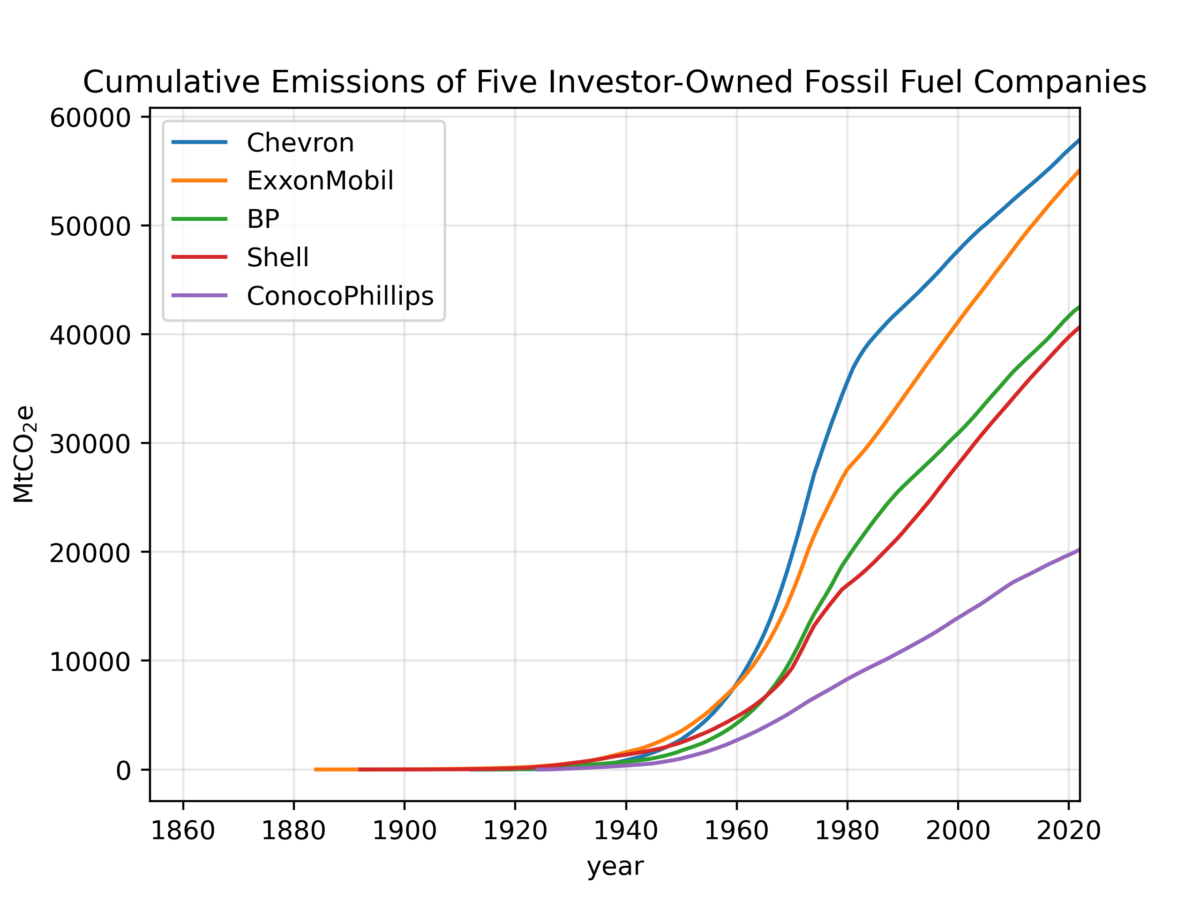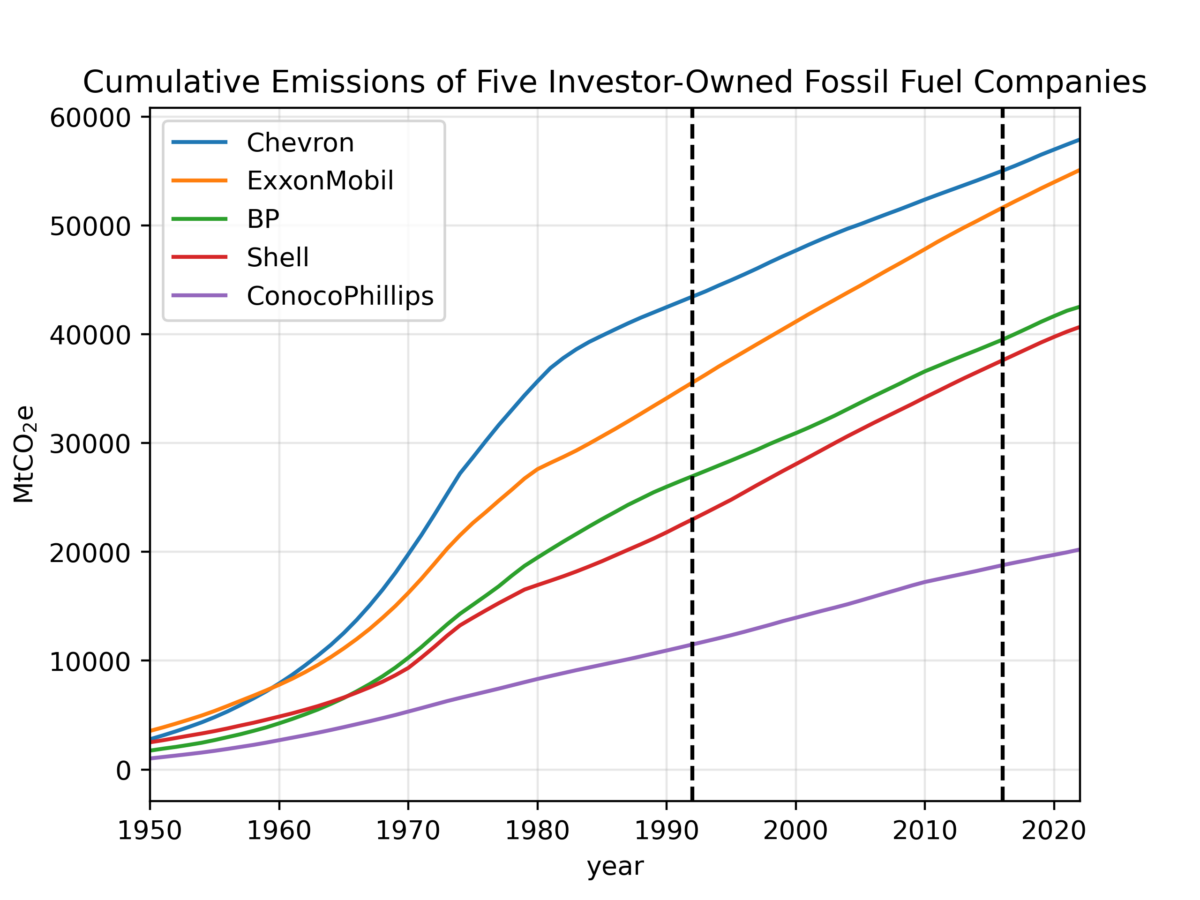A new dataset released by InfluenceMap provides information on heat-trapping emissions traced to the 122 largest investor and state-owned fossil fuel companies in the world. Fossil fuels are the main driver of climate change and the terrifying effects of it that we see happening across the world. That makes this dataset a powerful tool for understanding how each of these entity’s heat-trapping emissions have contributed to climate change.
I have been working with this new InfluenceMap dataset in my own research, and here I’ll share how I’m using it and offer a look at heat-trapping emissions from five major investor-owned fossil fuel companies: ExxonMobil, Shell, Chevron, BP, and ConocoPhillips. These companies have been polluting our planet for decades with impunity and they are planning to continue their harmful fossil fuel extraction despite global efforts to tackle climate change. As I show below, their cumulative emissions have continued to rise over the decades even as international efforts to confront climate change have been enacted through the United Nations Framework Convention on Climate Change and the Paris Agreement.
To learn more about the history of this dataset, ways researchers have used a previous version of it, and applications for new research and climate litigation, check out this blog post written by my colleague Carly Phillips.
Using data for litigation-relevant research
Since fall of 2022, I have been the Hitz Fellow for Litigation Relevant Research here at the Union of Concerned Scientists. My fellowship is based on using data that trace heat-trapping emissions to major fossil fuel producers in order to understand how they have affected the climate, particularly global sea levels, and to aid efforts to hold these producers accountable. Scientists tend to be more comfortable using our research to inform policy than to inform litigation so the phrase ‘litigation-relevant research’ may not be familiar to some readers. But this is a rapidly growing way to apply our skills as climate litigation begins to pick up steam around the world and researchers look for ways to help out. Last year my colleague Sarah Goodspeed put together a toolkit called Research on the Record, to help explain litigation relevant research to the broader research community. Check it out to learn more.
I am using this new dataset from InfluenceMap to work on two different research projects. One of them looks at how past emissions from fossil fuel companies will continue affecting sea levels for centuries to come. The other project uses the data to understand how fossil fuel production in specific countries relates to global efforts under the Paris Agreement to limit temperature rise to 1.5°C. I’m not going to share the results of those studies here since I need to preserve the scientific process and wait for my research to go through peer review, but I do want to share some things I’ve learned along the way as I’ve been working with this data. Let’s dig into it!
Exploring this new dataset
ExxonMobil, Shell, Chevron, BP, and ConocoPhillips have made headlines in recent years for the enormous profits they are raking in—more than $100 billion in 2023 alone. Meanwhile, climate impacts such as wildfires, floods, and severe storms continue to worsen, heat-trapping emissions continue to rise, and people around the world suffer immense harm from climate-fueled disasters. Fossil fuel companies’ billions of dollars in profits are coming from sales of their harmful products. In Figure 1 we can see the cumulative heat-trapping emissions from their fossil fuel production have increased significantly over the past 140 years.

The InfluenceMap dataset includes company-by-company data on emissions of carbon dioxide–the heat-trapping gas responsible for the largest contribution to climate change–and methane, a very potent heat-trapping gas that lasts a shorter time in the atmosphere. The unit used in the graph above, CO2e, is short for carbon dioxide equivalent–a unit that combines carbon dioxide and methane to tell us the equivalent heat-trapping emissions over a 100-year time scale. The main takeaway from this plot is that emissions from these companies’ products have increased over time by quite a lot!
Fossil fuel producers’ cumulative emissions increase
Climate science has evolved significantly over the past 140 years, and we know more now about how the climate system works than ever before. But scientists have known the basics of climate change since the late 1800s, and we certainly knew enough half a century ago to start sounding the alarm bells that heat-trapping emissions were becoming a growing problem for the planet. The fossil fuel industry knew that too. Uncovered documents have shown that several companies were even conducting their own internal research on climate change. ExxonMobil’s research has even proven to be accurate as we have seen global temperatures rise at approximately the levels projected in their research. Yet despite the company’s internal knowledge and the strong science that was publicly available, ExxonMobil and other fossil fuel companies did not realign their business models in favor of a livable future. Instead, they focused efforts on denying the science, deceiving the public, greenwashing their images, and lobbying against regulations. Let’s look at their cumulative emissions since the 1950s in Figure 2.

Rising emissions flout climate science
Even as the science advanced and people and policymakers around the world became increasingly concerned about climate change, heat-trapping emissions from the world’s largest fossil fuel producers continued to grow. By the early 1990s, countries around the world came together and established the United Nations Framework Convention on Climate Change (UNFCCC). Following that important development, annual international negotiations began to figure out how to achieve the goals of the UNFCCC.
After decades of these negotiations, the Paris Agreement was adopted in 2015 and ratified in 2016 (to read more about this history check out my peer-reviewed research here). I’ve marked these important years with dotted lines in Figure 2. As we can see, throughout these recent decades—despite the international efforts to address climate change and the scientific consensus showing that fossil fuels are the leading cause of climate change—the cumulative emissions from these major fossil fuel producers have continued to rise. They are taking us in the wrong direction, and we desperately need a change.
In this blog I have shown cumulative heat-trapping emissions from each of these companies. This is because cumulative emissions of carbon dioxide (CO2) are key for understanding global temperature rise. To quote the Summary for Policymakers from the Working Group 1 section of the Intergovernmental Panel on Climate Change’s 6th Assessment Report: “From a physical science perspective, limiting human-induced global warming to a specific level requires limiting cumulative CO2 emissions …. This Report reaffirms with high confidence the AR5 finding that there is a near-linear relationship between cumulative anthropogenic CO2 emissions and the global warming they cause.” The plots here show CO2e, but most of each company’s emissions are CO2 so these cumulative emissions plots give us a good idea of how each of these companies has continued to drive rising global temperatures over time. In a follow up blog I will break down each company’s annual heat-trapping emissions to compare what we can learn from that.
Sharply reducing emissions requires phasing out fossil fuels
The most recent IPCC report and United Nations Production Gap report show that fossil fuel producers must decrease their production, yet that isn’t what they have been doing in recent decades—and it isn’t what they are planning to do in the critical period between now and 2030. Climate justice activists and their supporters around the world have called for a fast and fair fossil fuel phaseout. The year 2023 was the hottest year on record (so far!); calls for accountability continue to grow louder.
This new dataset from InfluenceMap provides a powerful tool for researchers like me to understand where heat-trapping emissions are coming. That information can help as we work together to reverse these dangerous trends and build a better future based on clean renewable energy.

